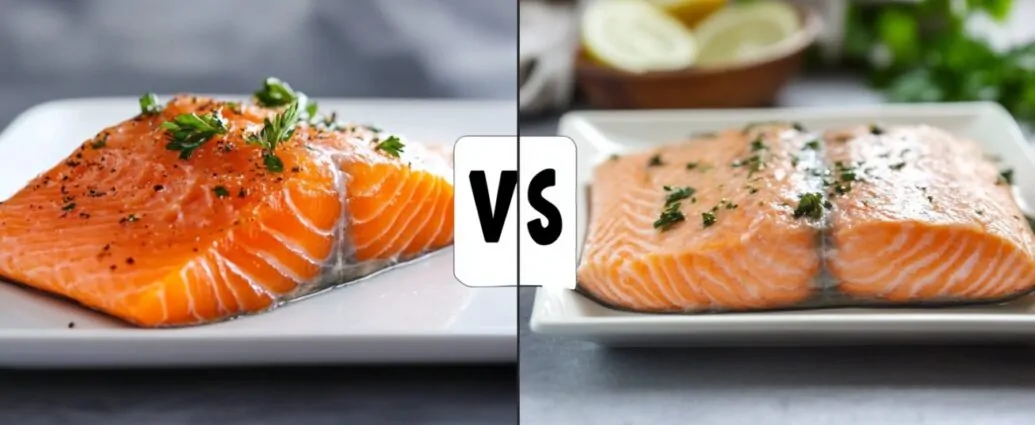Steelhead and salmon often confuse people at the fish market or on the plate. Their appearance might suggest a close match, but when it comes to flavor, texture, and nutrition, the differences are unmistakable.
For those who enjoy seafood, distinguishing between the two can influence everything from cooking methods to sustainability choices.
Nutrition Breakdown
| Nutrient | Steelhead Trout (Cooked, 100g) | Atlantic Salmon (Cooked, 100g) |
|---|---|---|
| Calories (kcal) | 140 | 206.00 |
| Protein (g) | 22 | 22.00 |
| Total Fat (g) | 5.9 | 13.00 |
| Saturated Fat (g) | 1.1 | 3.10 |
| Monounsaturated Fat (g) | 2.1 | 4.90 |
| Polyunsaturated Fat (g) | 1.7 | 3.90 |
| Cholesterol (mg) | 60 | 63.00 |
| Omega-3 Fatty Acids (g) | 0.95 | 1.95 |
| Omega-6 Fatty Acids (g) | 0.5 | 1.00 |
| Carbohydrates (g) | 0 | 0 |
| Sugars (g) | 0 | 0 |
| Fiber (g) | 0 | 0 |
| Vitamin B12 (µg) | 4.5 | 3.00 |
| Niacin (B3) (mg) | 5.5 | 7.00 |
| Vitamin B6 (mg) | 0.4 | 0.90 |
| Selenium (µg) | 18.5 | 36 |
| Phosphorus (mg) | 220 | 250 |
| Potassium (mg) | 450 | 450 |
| Vitamin D (µg) | — | 11.5 |
| Astaxanthin (mg) | — | 2.25 |
| Iron (mg) | 0.5 | 0.7 |
| Magnesium (mg) | 30 | 30 |
Fat content draws one of the clearest lines between steelhead and salmon.
Steelhead is notably leaner, containing fewer calories and lower fat levels. That makes it a solid choice for individuals focused on lighter meals or calorie-conscious diets.
Salmon, particularly when farm-raised, carries significantly more fat. That additional fat not only enhances its bold flavor but also makes it more filling, which can be useful for those seeking satiety in protein-heavy meals.
Both fish perform exceptionally well in the protein department, offering ample fuel for muscle maintenance, energy, and overall health. Omega-3 fatty acids are another area where both fish excel. Salmon slightly surpasses steelhead in omega-3 density, which may influence cardiovascular and cognitive health decisions for some consumers.
Nutrient availability can also depend on how each fish is raised. Wild-caught salmon often differs from farmed salmon in both nutrient density and fat composition, just as wild steelhead may offer slightly altered benefits compared to hatchery-raised versions.
Choosing between them means weighing not just flavor or texture but also the nutritional support they offer about dietary goals.

Origins and Biological Differences
Steelhead and salmon both belong to the Salmonidae family, a group known for fish that migrate between fresh and saltwater.
Despite sharing that family classification, their identities follow different paths. Steelhead is not a separate species but a sea-run version of rainbow trout.
Salmon, in contrast, encompasses multiple species such as Chinook, Sockeye, Coho, and Pink salmon, each with its own genetic traits and spawning behaviors.
- Steelhead: Genetically identical to freshwater rainbow trout but undergo physical changes to survive saltwater.
- Salmon: Represent several distinct species, each with a fixed lifecycle and specific habitat preferences.
Migration patterns further highlight their separation. Both are anadromous, meaning they migrate between saltwater and freshwater environments.
Steelhead showcases more adaptive survival behavior, often returning to the ocean multiple times over a lifetime.
Salmon, on the other hand, typically die after a single spawning event.
Such distinctions not only shape population dynamics but also influence fisheries management, cooking applications, and long-term environmental impact. Steelhead’s flexible pattern lends itself to different harvesting methods, while salmon’s rigid lifecycle often ties it to specific seasonal fishing windows.
Appearance

Visual similarity between steelhead and salmon can easily confuse even seasoned seafood buyers. Yet, when examined closely, physical characteristics offer several reliable ways to tell them apart.
- Size
- Shape
- Coloration
Steelhead usually grows larger than most commonly consumed salmon species. A standard adult steelhead weighs between 8 and 11 pounds, with a streamlined, elongated shape that reflects its trout lineage.
Salmon often falls in the 4 to 8-pound range, with a bulkier, thicker build that gives it a more compact appearance.
- Steelhead: longer, narrower body; more athletic and tapered.
- Salmon: rounder, deeper-bodied profile; thicker along the belly and shoulders.
Color adds another level of differentiation. Both types of fish have flesh with a pinkish-orange tone, but subtle contrast exists. Steelhead flesh tends to appear slightly lighter and less intense. Salmon’s flesh often showcases a deeper hue, sometimes verging on red-orange depending on diet and species.
Skin also sets them apart. Steelhead shows off a clean, silvery sheen with relatively sparse spotting, especially along the upper body and tail. In contrast, salmon features darker, more pigmented skin with dense spotting, particularly concentrated toward the rear half.
- Steelhead skin: bright silver tone, minimal dark spots, smooth gradient.
- Salmon skin: darker tones, heavy spotting near tail, more pronounced contrast.
- Steelhead flesh: light pink to orange, mild visual intensity.
- Salmon flesh: deeper orange or red, bolder coloration depending on type.
Paying attention to these subtleties helps make an informed choice at the counter or market, especially when labeling lacks precision.
Taste & Texture

Flavor becomes the dividing line for most people deciding between steelhead and salmon. Steelhead offers a gentle introduction to seafood. Its mild, sweet, and buttery profile appeals to those who prefer a lighter touch in their meals.
The absence of a strong “fishy” presence makes it suitable for more delicate flavor combinations and palates that may be sensitive to bold seafood notes. A simple lemon and herb preparation brings out its best qualities without overwhelming the senses.
Salmon offers a more assertive flavor. Often described as bold, rich, and occasionally nutty, it delivers a taste that holds its own against powerful marinades or robust cooking methods. Smokers, spice lovers, and fans of hearty seafood dishes typically gravitate toward salmon.
Its flavor remains consistent and full-bodied across species like Chinook or Sockeye, making it a dependable star in many kitchens.
Flavor profile breakdown:
| Aspect | Steelhead | Salmon |
|---|---|---|
| Flavor | Mild and slightly sweet | Bold and pronounced |
| Mouthfeel | Buttery and smooth | Often has a nutty undertone |
| Taste Notes | Less “fishy” taste | More “ocean-forward” and savory |
Texture brings another layer of distinction. Steelhead features a softer, more delicate texture that practically melts when cooked gently.
It responds best to cooking techniques that preserve its tender quality, such as poaching, steaming, or pan-searing with minimal oil. Flaky and moist, it flakes apart effortlessly with a fork.
Salmon brings weight and structure. Its firmer, denser bite is well-suited for aggressive techniques like grilling or broiling, where the meat needs to hold together. The higher oil content contributes to a rich mouthfeel and helps it retain moisture even under intense heat.
Texture comparison:
| Feature | Steelhead | Salmon |
|---|---|---|
| Texture | Softer and more delicate | Firmer and denser |
| Best Cooking Methods | Poaching, steaming, pan-searing | Grilling, broiling, roasting |
| Moisture & Feel | Flaky and moist | Higher oil content, retains moisture well |
Those who prefer light and refined textures may find steelhead a better fit, while those seeking a full-bodied bite with rich taste and hearty satisfaction often choose salmon.
Wrapping Up
Steelhead and salmon may mirror each other in shape and color, but their culinary and environmental identities couldn’t be more different.
Flavor, texture, and nutritional balance create clear boundaries.
Choosing between the two often comes down to personal taste, cooking intent, and a commitment to responsible consumption.



